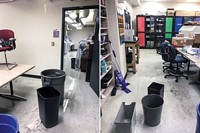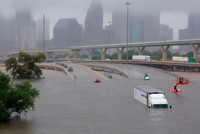Advertisement
Grab your lab coat. Let's get started
Welcome!
Welcome!
Create an account below to get 6 C&EN articles per month, receive newsletters and more - all free.
It seems this is your first time logging in online. Please enter the following information to continue.
As an ACS member you automatically get access to this site. All we need is few more details to create your reading experience.
Not you? Sign in with a different account.
Not you? Sign in with a different account.
ERROR 1
ERROR 1
ERROR 2
ERROR 2
ERROR 2
ERROR 2
ERROR 2
Password and Confirm password must match.
If you have an ACS member number, please enter it here so we can link this account to your membership. (optional)
ERROR 2
ACS values your privacy. By submitting your information, you are gaining access to C&EN and subscribing to our weekly newsletter. We use the information you provide to make your reading experience better, and we will never sell your data to third party members.
Lab Safety
California researchers learn to roll with power outages
Bay Area blackouts this month highlight potential risk to power-sensitive research
by Kerri Jansen
October 29, 2019

Last Friday, for the second time in less than a month, researchers at the University of California, Berkeley faced a possible power outage in their labs. The campus’s power utility, the Pacific Gas and Electric Company (PG&E), has been implementing planned, rolling blackouts throughout the state during particularly hot, windy weather in an attempt to reduce the risk of damaged electric lines sparking fires in the parched landscape. From Oct. 9–12, the utility cut power to more than 700,000 customers in northern and central California, including on the UC Berkeley campus. On Friday, PG&E warned more outages would be possible over the weekend, and the company disconnected power to the campus on Saturday night. Power remained off into Monday.
And these situations could happen yet again. Rising global temperatures, longer wildfire seasons, and an ever-present earthquake risk are making power outages more common for California universities and researchers. Though PG&E is working to upgrade its electric system to make it safer in dry, windy weather, the company’s president and CEO has estimated it could take the company up to 10 years to complete that work, according to reporting from the Wall Street Journal. For researchers who rely on temperature-controlled equipment to store biological samples and expensive reagents, power outages represent not just safety concerns and lost time in the lab, but the potential to derail years of research.
At UC Berkeley earlier this month, Sarah Morris was among the researchers scrambling to connect critical equipment to backup power when it was available, and find alternative solutions when it was not. Morris is a graduate student in comparative biochemistry who works in a building that does not have a backup generator. Her research involves mammalian cell lines that must be kept at a specific temperature and CO2 level. If her incubators lost power, it could mean months of work erased.
“These particular cell lines took about a year and a half to actually develop and grow,” she said. “I was in the middle of an experiment that had really, really set time points in which I could treat and assess the conditions of growth, and the outage happened right in the middle of it.”
Morris was able to find another lab on campus that had backup power and room to house her experiment during the outage. Unsure of how long their building would be without power, her group also sent some critical freezers to a nearby lab at the University of California, San Francisco, which was not affected by the shutoff. On Twitter, group leader James Olzmann called the process “incredibly disruptive.”
Researchers across the Berkeley campus felt the disruption too. On Oct. 8, after receiving word that power was to be shut down the following morning, postdoc Thomas Burke and colleagues worked into the night and early the following morning to shut down experiments and prepare their equipment for the outage. The building where his lab is located has a backup diesel generator, and there are a limited number of emergency outlets throughout the building that would stay energized during a power outage—about one per lab, Burke says. But the lab relies on multiple freezers to store not only the genetically modified bacteria he uses in his experiments, but also decades-old experimental samples from other researchers and expensive serums and antibodies.
“The potential for losing them would be disastrous,” Burke says. “We’re talking about dropping all of our other work and having to just focus on remaking stocks for months, or, depending on how bad your luck is, it could take years. So it would be devastating.”
Burke’s team tracked down enough available emergency outlets in other parts of the building—including one in the building’s lunch room—to keep the lab’s most critical equipment running during the shutoff. They packed the remaining freezers with ice, hoping the freezers could stay cold for a few days on their own. Then they waited for the power to go out.
Although coping with an intentional power shutoff was a new experience for UC Berkeley, unannounced power outages have hit other universities throughout California.
Craig Merlic, chair of the University of California, Los Angeles’ Chemical and Physical Safety Committee, remembers when the Northridge earthquake knocked out power to the university for 2 days in 1994. He was an assistant professor at the time and had just moved into a new building that had a backup generator, although other researchers may not have been so fortunate.
He thinks the university is even better prepared for an emergency now. These days, in addition to providing emergency backup power circuits in every lab, the university emphasizes making sure experiments can “fail safe,” meaning the experiments won’t create a safety hazard if left unattended, which is especially important for experiments involving high pressure and heat. At UCLA, many labs that use water to cool experiments have flow monitors that, in case of a cooling water outage, turn off the heating power, Merlic says. The university’s environmental health & safety officers check for fail safe protections during their annual inspections. And Merlic, along with the university’s vice chancellor for research, has challenged the EH&S office to explore whether even more can be done to ensure experiments fail safely. These measures are important considerations for all researchers, not just those in California, he notes, because even in areas unaffected by wildfires and earthquakes, tornadoes and hurricanes can also cause power and water outages.
At the University of Southern California, chemistry department chair G. K Surya Prakash says the primary research-related concern during a power outage would be the department’s large instruments, such as mass spectrometers equipped with vacuum pumps. Uninterruptible power supplies connected to the department’s major equipment will supply 5–6 hours of backup power in case of an outage, he says, which should be enough time for people to go in and power down the instruments safely.
Uninterruptible power sources are also available at Stanford University for researchers who need them, along with emergency circuits powered by a generator at each lab building. At California Institute of Technology, all core science buildings, including chemistry and biochemistry labs, are connected to backup generators that power fire and safety systems along with some emergency circuits, says John Onderdonk, senior director for facilities services and planning. And uninterruptible power modules are available to researchers who need them. Caltech is also keeping backup power in mind when planning new buildings. The Chen Neuroscience Research Building, currently under construction and scheduled to open in the fall of 2020, will be powered by a natural-gas fuel cell that can operate independently from the utility’s electric grid.
At UC Berkeley, Thomas Burke’s bacterial stocks survived the first shutoff earlier this month. In fact, his building never actually lost power, he says; the university’s cogeneration plant was able to provide limited power to the campus throughout the shutoff, enough to support critical equipment. A university statement prior to the second shutoff this past weekend stated that the cogeneration plant should be able to again support essential research operations during future outages, as long as people use the power only for critical tasks.
Nevertheless, the announcement of a second shutoff was frustrating news for researchers who were still recovering from the first disruption to their work. Days after the first outage had ended, Sarah Morris was still assessing whether her cells had been affected.
“It’s really a sense of helplessness,” Morris said after the first power outage. “I mean, yes, I can maintain my projects, I can just hold. But I can’t progress anything.
“Right now, when I’m planning future experiments, I’m also looking at the weather report.”




Join the conversation
Contact the reporter
Submit a Letter to the Editor for publication
Engage with us on Twitter